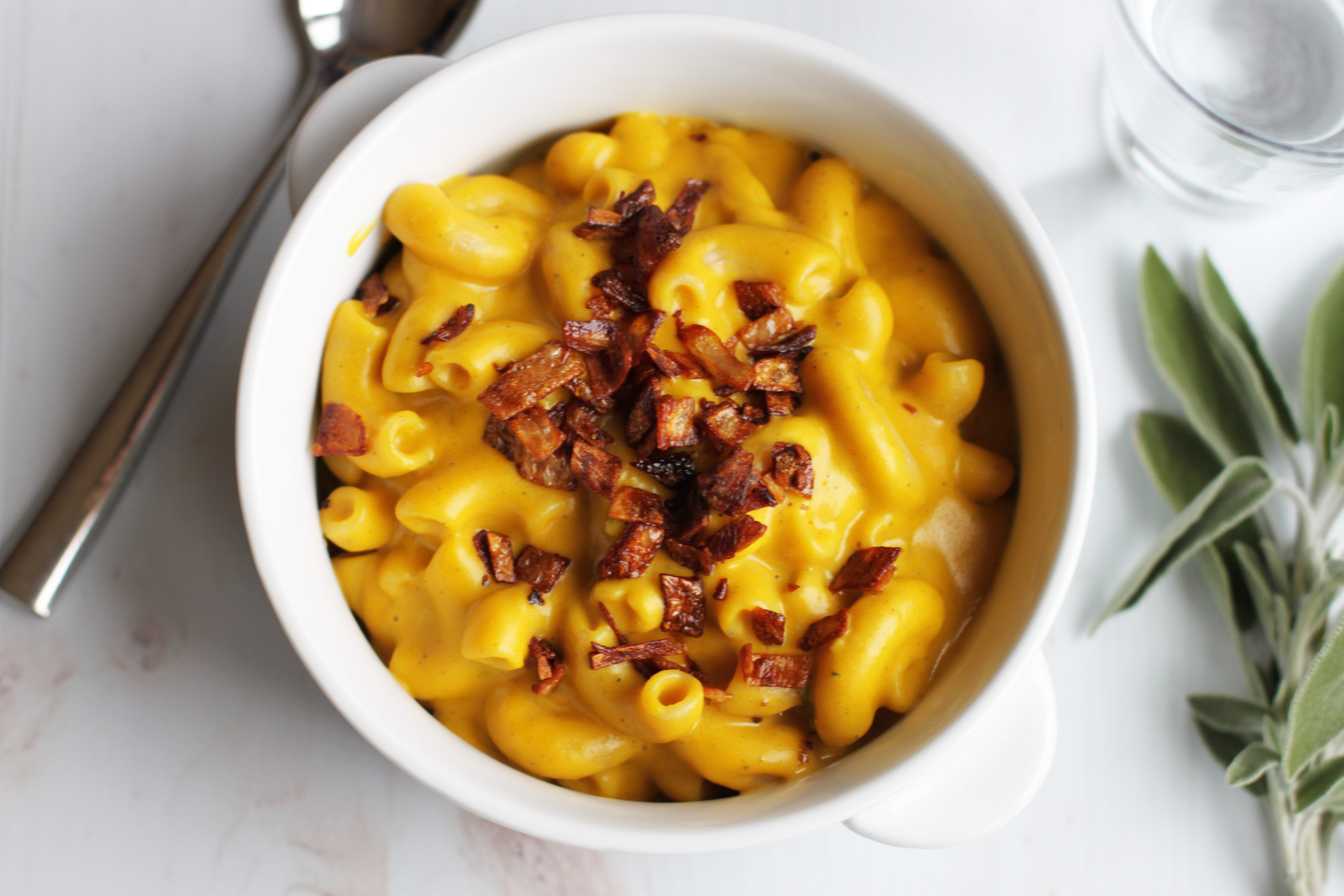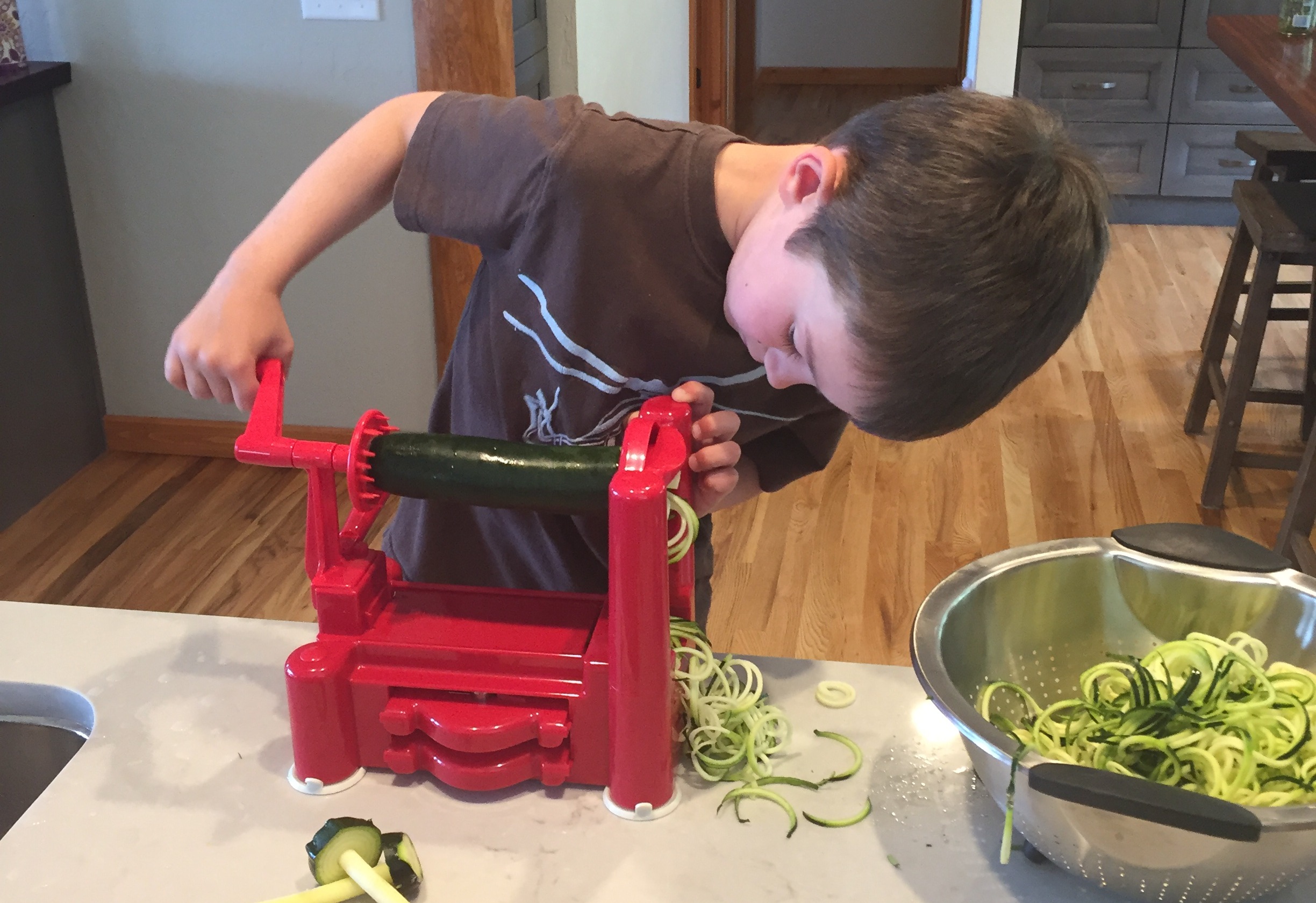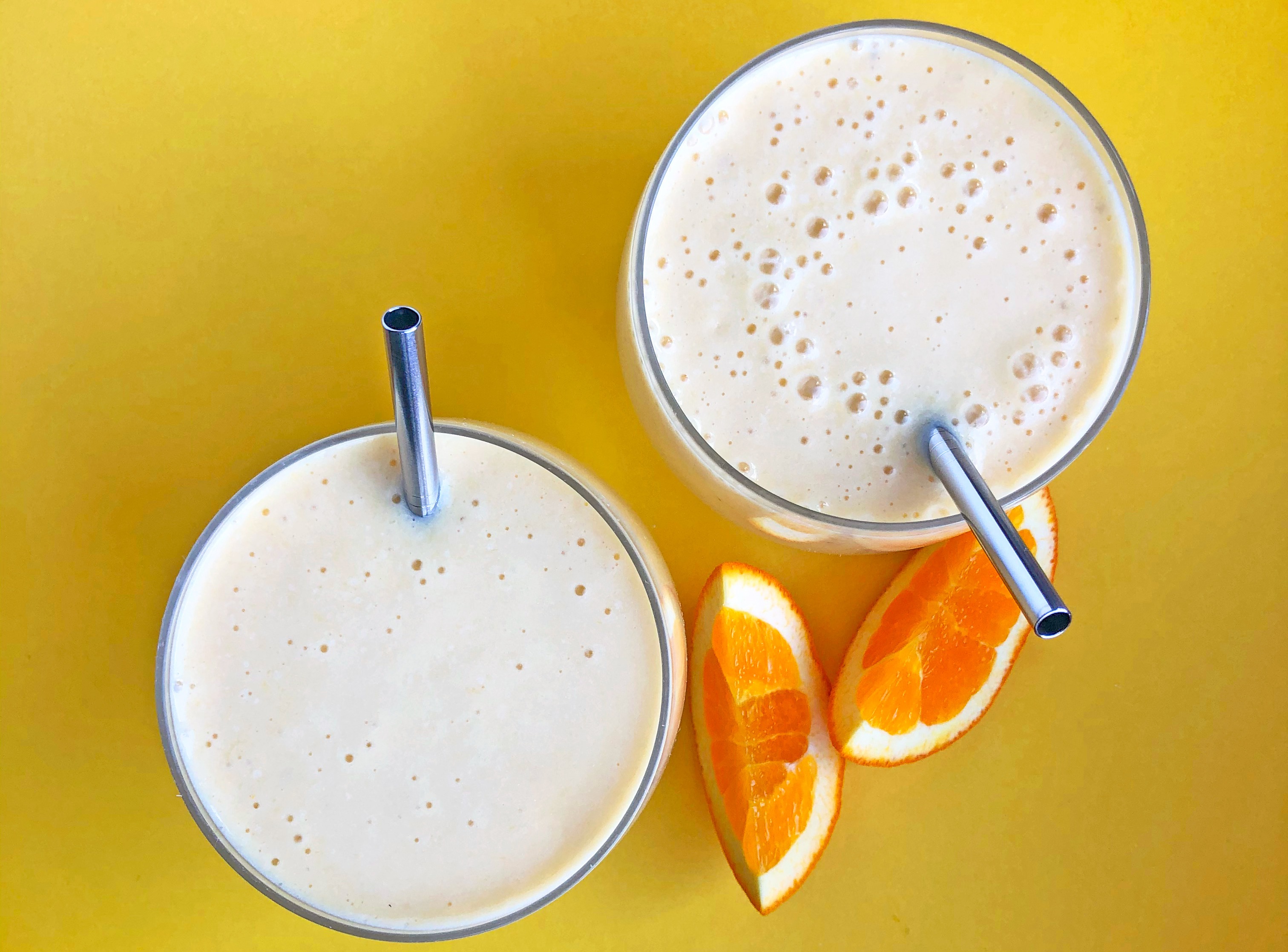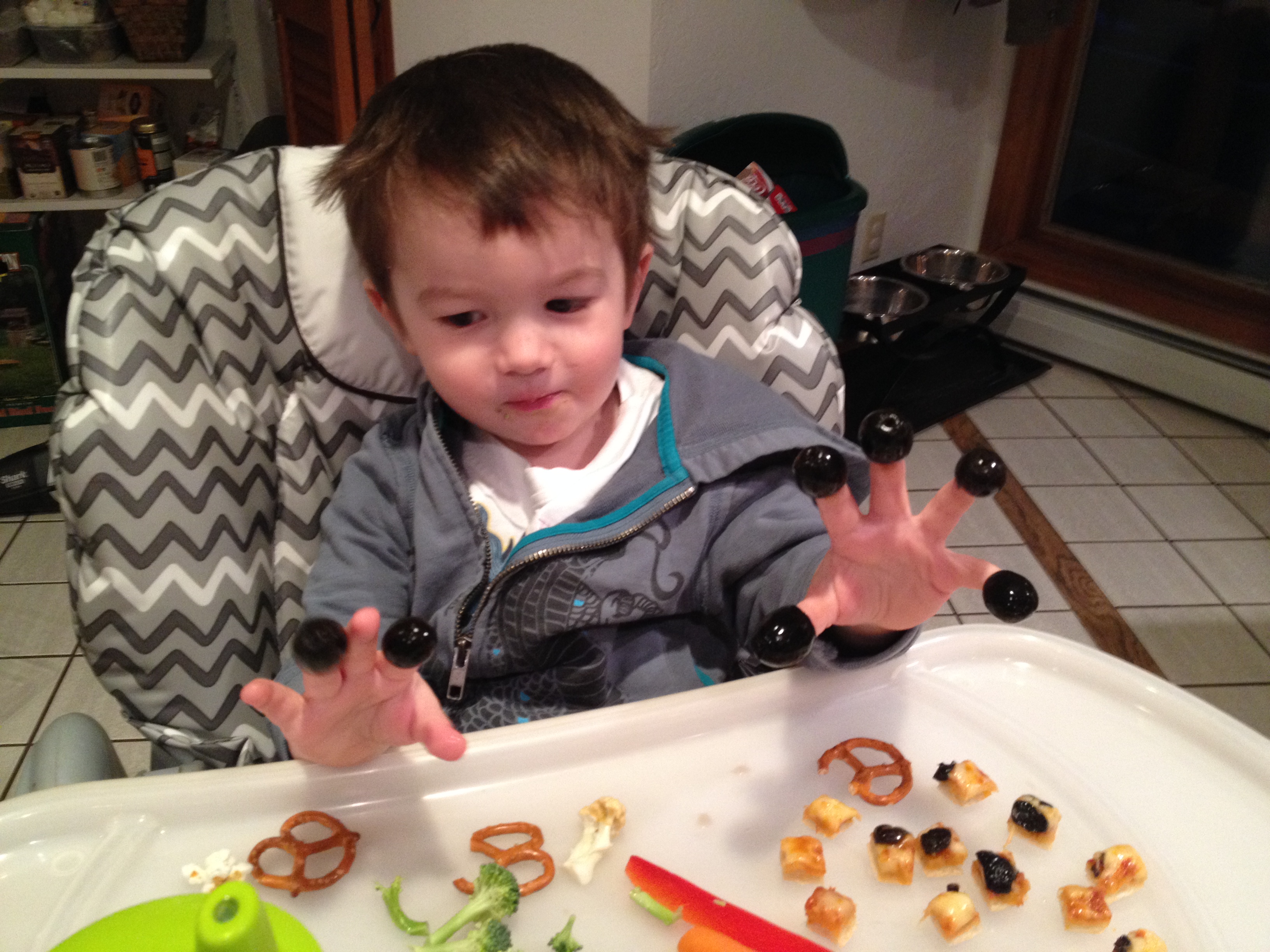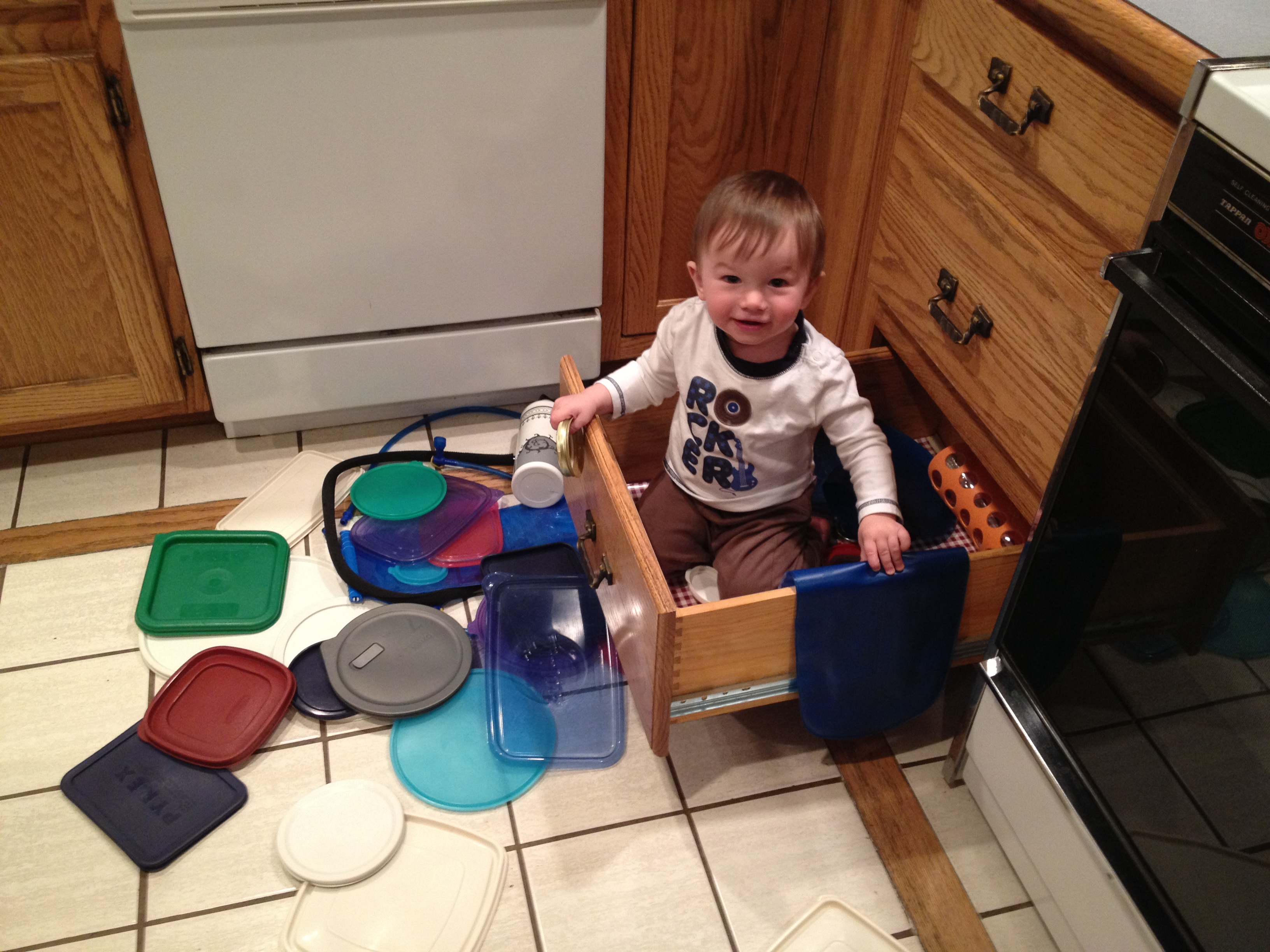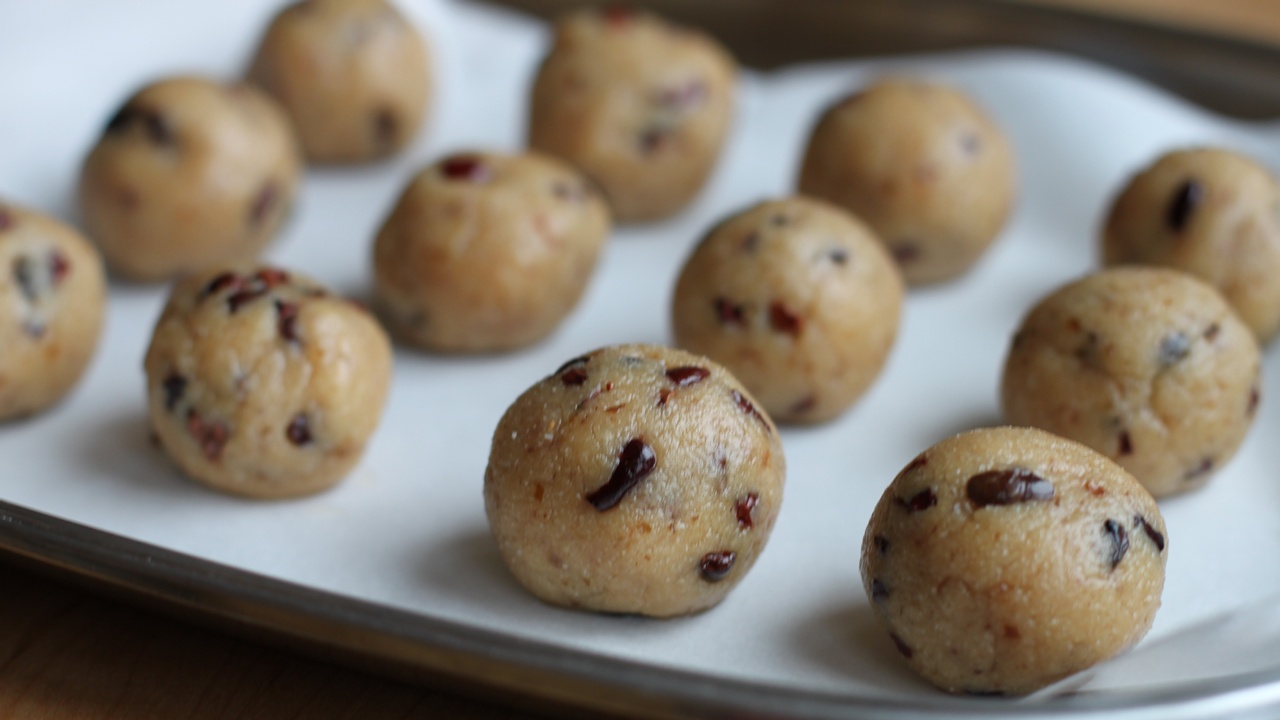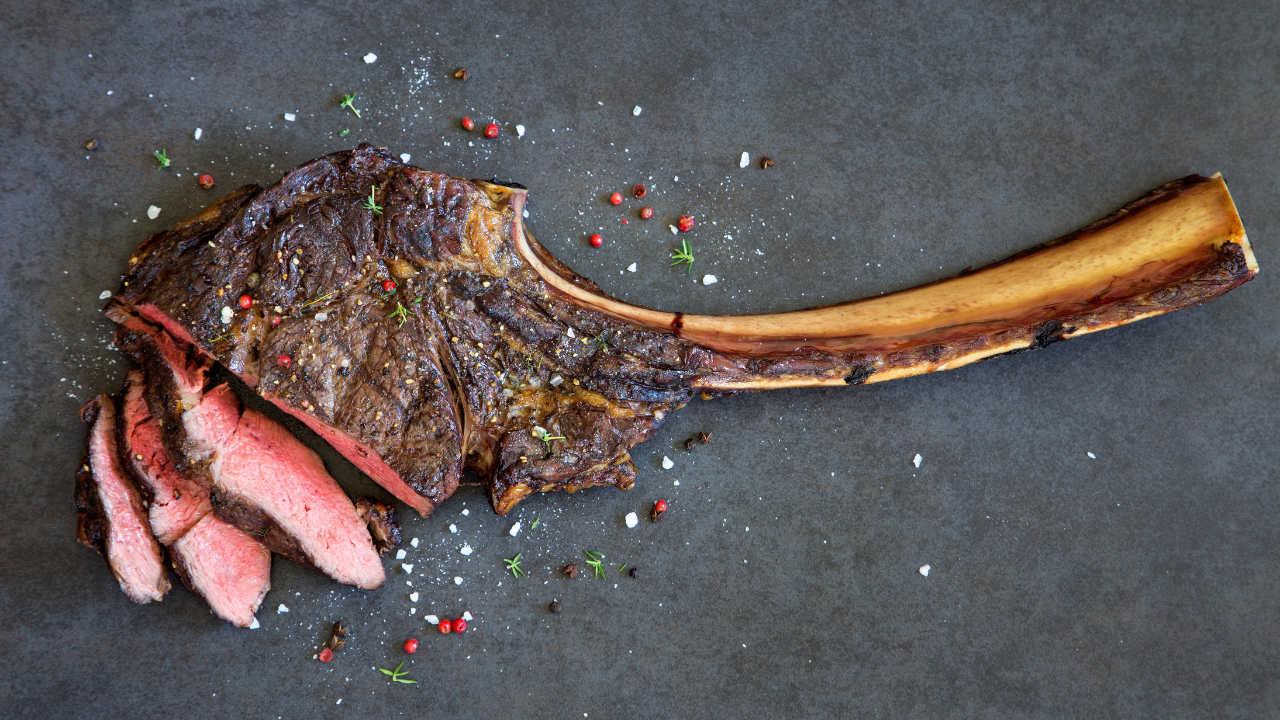10 Ways to Get Kids to Eat More Fruits and Vegetables...Willingly
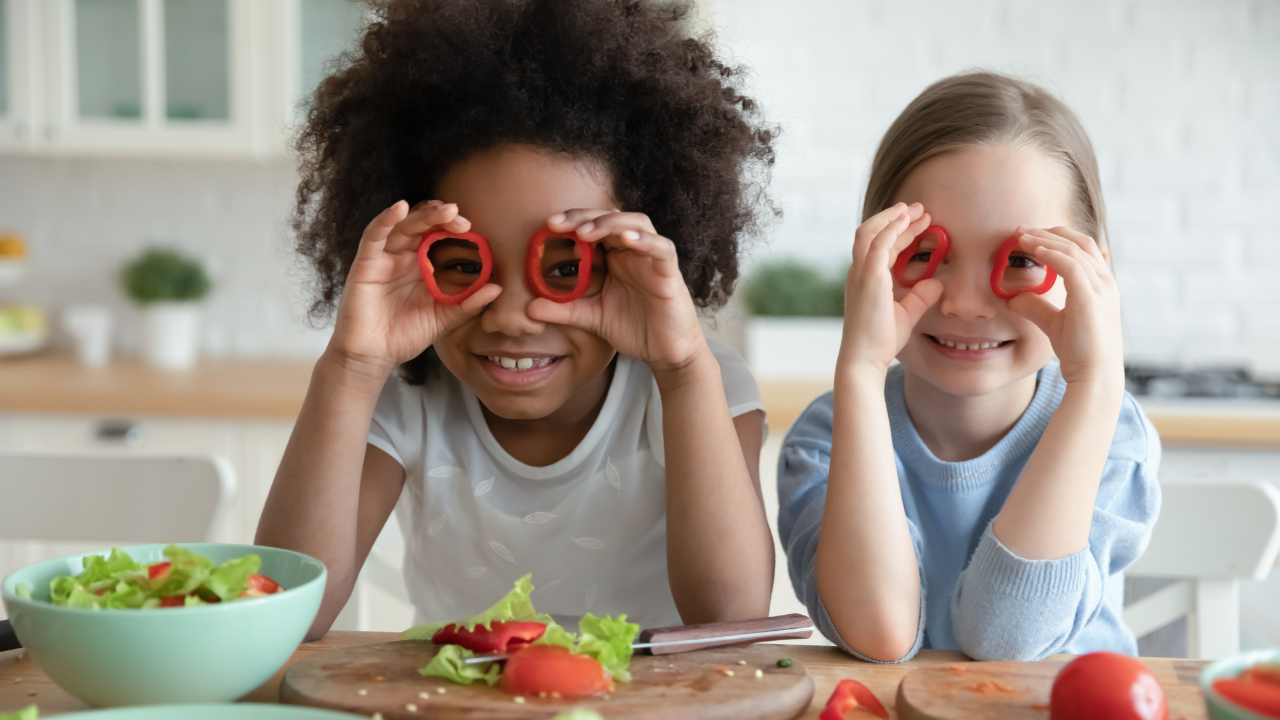
Raising healthy eaters is tricky business. Parents go to great lengths to get fruits and veggies into their kids' mouths– hiding them in muffins, blending them into pasta sauce, and disguising them in nugget form.
While there are plenty of cookbooks and recipes out there to help you devise sneaky ways to hide veggies in your kids' meals, in this article, we’re going to focus on how we can get kids to willingly eat more fruits and vegetables.
In other words, you don't necessarily have to trick your kids to get them to eat more produce. In this article, I’m going to share 10 ways to entice your kids to eat more fruits and vegetables.
Full disclosure: Some of the links in this post may be affiliate links. As an Amazon Associate, I earn from qualifying purchases. Purchasing a product using one of these links will support my work at no additional cost to you. Please know that I only recommend products I wholeheartedly stand by.
Children can be notoriously picky eaters, leading parents to agonize over getting them to eat more fruits and vegetables. As shown in the below photo, the struggle is real.

James' s dinner review: Quinoa & salmon, 99% good. Veggies, 100% bad. RIP veggies.
My son James knows exactly what he likes and doesn’t like and has put us through our paces with his food preferences, hunger strikes, negative reviews, and surprisingly effective negotiating skills. But sticking with it and continuing to implement these ways of making fruits and veggies more appealing has paid off.
James is 10 years old as I write this, so these tips and ideas are geared towards kids 10 and under, but many can be adapted to older kiddos too. While all kids are different, these are the things that worked for us. I hope it provides some tactics that work for you too.
I’m not a parenting expert (obviously), but I am a Cordon Bleu-trained chef, cooking instructor, health coach, Hashimoto’s patient, and mom. If you read through to the end you’ll see the biggest reward so far that resulted from our dogged efforts to raise a healthy eater.
Captain Sweet Potato
Tip #1: Start Them Young
When you’re new to the world, everything is new to you, and with that comes an innate open-mindedness. If there was one thing I wish I would have realized when James was starting on solid foods is how precious that opportunity is.
While babies certainly have their food preferences in regards to texture, type, color, and flavor of foods, parents can put all kinds of different things in front of their kiddos, especially fruits and veggies. You never know what they’re going to love!
As parents, we are taught by advertisements and restaurant menus that kid food is somehow different from adult food. We also project our own food preferences onto our kids and say things like, “Oh, you won’t like that.”
These common mindset roadblocks push us to resort to those typical “kids menu” foods like noodles, nuggets, pizza, grilled cheese, and hot dogs. While these foods have their place and are certainly well-liked, the irony is that they’re not going to provide the diversity of vitamins, minerals, and other nutrients that on which growing bodies thrive.
What these “kids menu” foods do is introduce kids to the world of beige-colored comfort foods that are hard to compete with, even for adults. Put a piece of broccoli and a piece of buttered toast in front of a kid and it’s not hard to guess which one they’re going to reach for.
So many factors can drive us to turn away from the foods we think of as less appealing to kids (especially vegetables), but as our pediatrician told us, “Kids will eat when they’re hungry. Keep putting those healthy choices in front of them, and eventually they’re going to eat them.” The sooner you start, the better.
Tip #2: Put on a Happy Face
For younger kids, putting a happy face on their plate is more than just a way to delight them. It could actually inspire them to eat what’s on their plate!
We are hard-wired as humans to be attracted to smiling faces. According to researchers, “Happy faces communicate an invitation to interact.” This invitation to interact is exactly what we want to provide when we put a plate of healthy whole foods in front of our child.
- A waffle smeared with peanut butter with banana eyes, a strawberry nose, and a blueberry smile.
- A selection of protein, fruits, and vegetables arranged into a simple smiley face design on a plate.
- A selection of veggies and dip with tomato eyes, olive nose, carrot hair, and cucumber smile.
These are just a few ideas of how you can make fruits and veggies more appealing with a smile. In his early years, this tactic worked on my son pretty much every time. It enabled us to build positive feelings around healthy, colorful fruits and vegetables, and meet our kiddo on his level: ready to giggle, be silly, and make fruits and veggies fun!
Tip #3: Eat the Rainbow
Like smiley faces, kids are attracted to more colors on their plates. In fact, Cornell researchers found that kids prefer more colors and more foods on their plates than adults. To be specific, they found that children were most attracted to plates with seven different items and six different colors on their plates. For parents, the easiest way to pull that off in a healthy and doable way is by incorporating lots of colorful produce.
Eating the rainbow obviously isn’t about Skittles. It’s about eating a diverse variety of plants of all colors. Eating the rainbow provides our bodies with a broad spectrum of the more than 25,000 different phytonutrients provided by various plant foods of various colors. The more colors on our plates, the greater the variety of health-giving phytonutrients our bodies are getting.
For growing bodies, that’s an especially good thing and something kids who know their colors can easily tap into. There are loads of online worksheets, checklists, and other resources for parents about eating the rainbow.
One example, and something James loved as a toddler were colorful summertime picnics at the park. I would bring a selection of colorful finger foods in a silicone container that was designed to freeze portions of baby food. In each 5-ounce well, I would place a different item, including some familiar kid favorites like crunchy crackers, some finger-food protein like our favorite nitrate-free diced ham, and the rest would be fruits and vegetables. Sometimes I would include a dip like hummus.
For a finicky kid like James, who was easily distracted and could be a very light eater, it was difficult to get him to sit and eat a healthy meal at the playground, but this colorful picnic approach with lots of choices was a winning formula.
This “Eat the Rainbow,” approach also gives parents an opportunity to talk to kids about nutrition on a level they can relate to.
As a toddler, that variety of colors was like eye candy for James, drawing him in and getting him to put those fruits and veggies into his mouth. As he became a little older (around age 7), he really connected with the Eat the Rainbow conversation at the dinner table, even going so far as to suggest we add purple kale to our plates in an attempt to get all 7 colors in one meal-- a parenting WIN!
Tip #4: Get Your Kids Involved in Growing and Harvesting Food
There’s something miraculous about a sprouting seed, a growing vegetable, or a wild berry. Kids love to grow and pick food. You don’t need a big vegetable garden or even a yard. Growing can be done in a pot indoors. Getting kids involved in this process helps them put the pieces together about where our food comes from, and the work and resources that go into it (like good soil, sunlight, and water).
This grassroots understanding of where food comes from fosters a clearer understanding of the big picture issues we try to teach our kids about food, like why we should try not to waste it. Best of all, when kids have a hand in growing foods, they’re much more inclined to eat them!
What started James eating kale was a field trip to a local organic farm, where they got to pick and eat veggies straight from the garden. What started James eating tomatoes, and snap peas was our own little vegetable garden. What sparked James’ love of mushrooms was our morel mushroom hunting forays into the mountains, and what got him hooked on huckleberries was picking them in the wild.

Fort Deer-proof, our enclosed, raised-bed garden
We have a small enclosed vegetable garden that James has enjoyed helping me in since about age 3. At first, he helped me dig holes, plant seeds, and water. At age 10, I have a real helper who likes to turn the soil with a pitchfork, pull weeds, and harvest. He’s also become quite the tomato bandit who can’t resist the lure of those home-grown cherry tomatoes still warm from the sun.
If growing your own, or heading into the woods to harvest wild food isn’t your thing, you can search for you-pick farms in your area. This can be a great way to connect with and support your local growers, get affordable high-quality produce, and spend some quality time with your littles. While they may eat most of what they pick, berry picking is an activity kids of all ages seem to enjoy and take to instinctually.
Pumpkin Sage Macaroni & Cheese
Tip #5: Don't Make Separate Meals; Make Adapted Meals
One of the most common questions I get from parents is how do I eat healthy whole foods without having to make separate meals for my family? Nobody, not even a chef like me, wants to make two dinners, and this can be a big deterrent for those of us trying to eat for our health.
The good news is that there’s an easy solution: Don’t make separate meals. Make adapted meals.
What this means is that instead of popping those frozen fries and nuggets into the oven for the kids while you make a salad for yourself, you instead adapt the salad for your kids. The same works for saucy stir-fries, spicy curries, and other entrees that are mixed up, or otherwise not agreeable to finicky kids.
Here's an example: While his dad and I prepare a spicy Thai curry with chicken, cooked peppers, peas, greens, and carrots in a coconut milk sauce, we set aside some of our ingredient prep for James’s plate (carrot sticks, bell peppers, peas). We add some of the cooked and lightly seasoned chicken, and some of the rice we will serve our curry on top of.
The result? A simple dinner in a kid-friendly format, that took minimal extra time to prepare, and that was composed of the same foods we were eating.
For many years, James turned his nose up at cooked vegetables and spicy sauces, but this approach enabled us to share a meal made from the same basic ingredients. At age 10, he's beginning to enjoy things like Thai curry, complete with cooked veggies and mildly spicy sauce. Adaptable meals gave us a way to ease him towards these more complex dishes, in baby steps.
Some adaptable recipe examples:
- While you enjoy this Tropical Chicken Salad, your kids can have a plate filled with shredded chicken, diced mango, cubed or mashed avocado, and plantain chips– all the components of the salad, minus things they might be averse to like lettuce or cilantro lime vinaigrette.
- Burger night for your kids can be burger salad night for you. See my recipe for Deluxe Burger Salad with Special Sauce.
- Kid favorites like macaroni and cheese can be made in a way that not only fits your dietary needs but incorporates veggies like winter squash. James loves my recipe for Pumpkin Sage Macaroni and Cheese, in spite of still adamantly insisting that he doesn’t like winter squash.
- While you might prefer your chili topped with gluten and dairy-free options like avocado, roasted sweet potatoes, and cilantro, your kiddo can load theirs up with traditional faves like shredded cheese, crushed tortilla chips, and sour cream (or however they like it). Recipes like my Loaded Secret-ingredient Chili make dinner a customizable build-your-own affair, which can go a long way in getting kids excited about their meals.
Make sense? This adaptable approach takes the tiniest bit of forethought, but saves you from making two meals, and falling back on less-nutritious convenience foods for your kids.
Tip #6: Model Healthy Choices
While kids might sometimes do what we say, they will certainly do what we do. According to researchers, kids begin to mimic our food choices from a very young age. Your choices and behaviors around food, perhaps more than any other factor, will dictate their choices and behaviors around food, from childhood through adulthood.
In other words, don’t underestimate the power of your example.
One of many silver linings of my Hashimoto’s diagnosis is that it’s made me much more aware of and diligent about my food choices. Eating lots of fruits and vegetables, and cooking from scratch is the norm for James’s dad and me. While we have fretted and fussed over our child’s pickiness, and his penchant for what we consider junk food, we’ve also seen how our mostly-good choices have rubbed off on him over time.
Good choices or bad, your kids are keenly witnessing you at every meal. While not every meal has to be nutritionally immaculate, knowing the power of our example can provide welcome inspiration to us as parents to embrace and model our own healthy choices.

Test pilot and taster-in-chief, Commander James.
Tip #7: Recruit Taste Testers
Contributing to a meal, even in a small way, can go a long way toward getting kids excited to eat it. One very simple way you can invite your kids to contribute is by recruiting them as your official taste testers.
Asking your kiddo, “Can you taste this and tell me what it needs?” can be a prideful moment for a kid. Not only does it make them feel like their input matters, it teaches them a basic yet very important cooking skill: tasting and “finishing” a dish.
I have recruited James as my official taste tester starting before the age of 5. He has a pretty keen palate but tends to go heavy on the salt, so it’s important to work with your kids' strengths and tastes here. In other words, he’s not the one pouring in the salt. : )
There’s also a powerful timing tactic you can leverage while recruiting taste testers. While you’re preparing a meal, tummies are often starting to growl, and food smells are coming from the kitchen. This is a great time to give your kids a sample of what’s on the menu, and hopefully, get them excited to eat it.
The French call this delicious bite or spoonful an Amuse Bouche, which is meant to amuse the mouth, and stimulate the appetite. Yes, please!
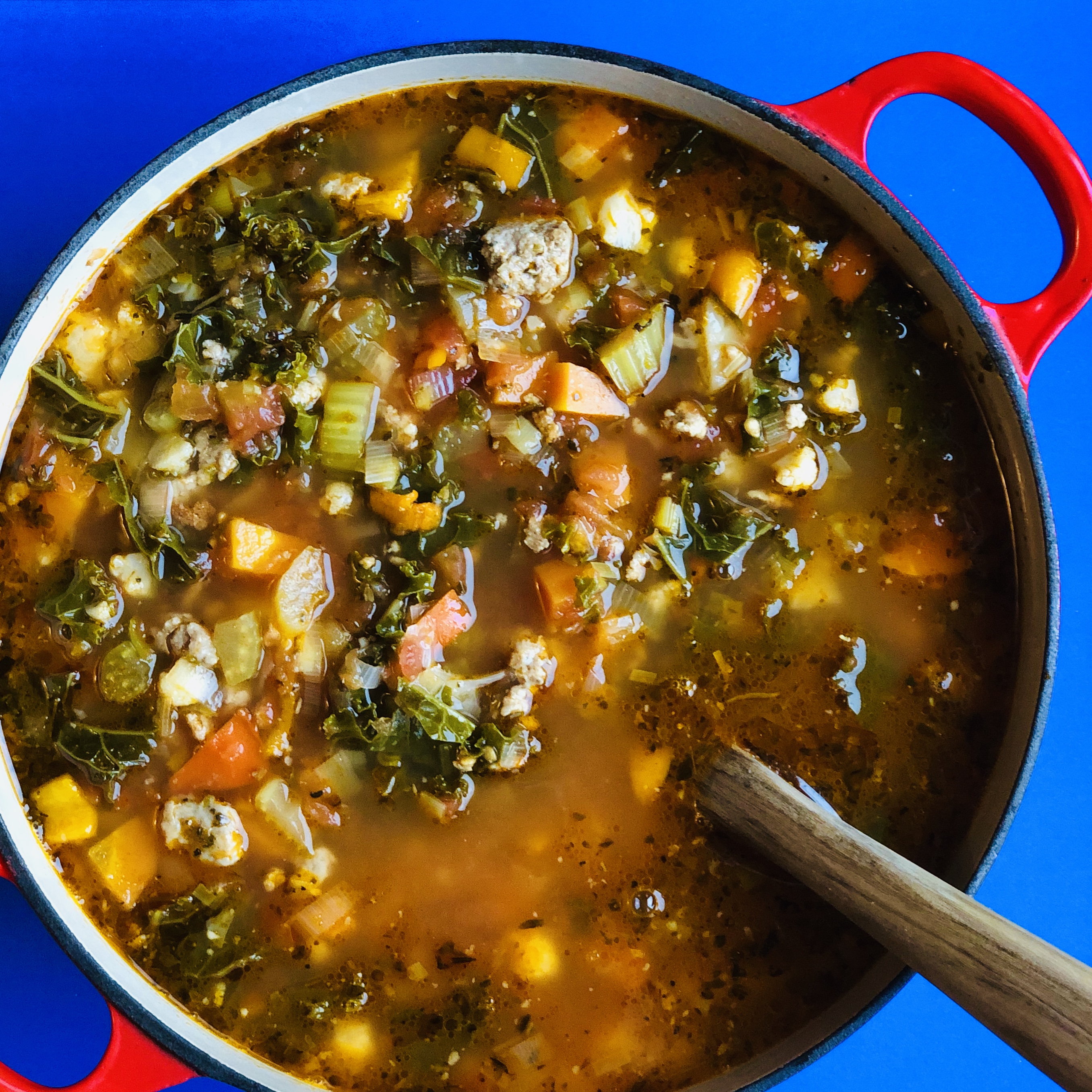
One recent winter evening, I gave James a spoonful of this Italian Sausage Minestrone. This particular instance with this particular soup stood out to me because it is basically a bowl full of vegetables. And not just vegetables but cooked vegetables– a common source of contention with James.
I knew this meal might elicit some grousing from James, so I asked him to be my official taste tester, offering him a spoonful while his tummy was starting to growl.
He not only declared that the spoonful I gave him was, "Yummy," but that it needed, "A little more salt, Mom."
Together we added and tasted, added and tasted until it was just right. James ate his entire bowlful of minestrone at dinner that night, including the veggies-- a win-win!
James making "Zoodles" with our spiralizer (after lots of coaching to not touch the blade).
Tip #8: Recruit Prep Cooks
Along similar lines, getting kids involved in meal prep can be a huge confidence builder, teach lifelong cooking skills, and lead to them being invested enough in the meal to eat it, veggies and all!
A few easy ways to involve kids in fruit and veggie prep:
- Give kids a vegetable brush and ask them to scrub the potatoes, carrots, or other root vegetables. This can be a safe and easy way to involve even the youngest kids.
- Even children as young as toddlers (depending on the kid) can be taught how to use a kid-safe knife, or a butter knife and cutting board to cut up soft foods like strawberries, melon, or bananas for a simple fruit salad.
- Give your kids a potato masher and ask them to help you mash up some diced avocado mixed with lime juice and salt to make a simple guacamole (while you hold the mixing bowl). The first time I let James do this he was still in his high chair and ate the entire bowl!
- If you have a spiralizer, kids love helping to crank and turn zucchini and other veggies into curly noodles. This requires more help and supervision due to the sharp blade, but can get them excited enough to actually eat those spiralized veggies at meal time.
- Baking is a surefire hit with kids because they love to scoop, measure, dump, and stir. It’s like the sandbox or making mud pies, except that with your help they can enjoy the reward of something delicious to eat as an end result. Blueberry muffins and pumpkin bread are some of James’ favorite baked goods featuring fruits and veggies.
Banana Orange Creamsicle Smoothie
Tip #9: Blend It!
Texture can be a real sticking point with kids (and adults) when it comes to fruits and veggies. One of the easiest ways around this is to blend them up. Smoothies are a great way to get kids to eat more fruits and vegetables. Give them a say about what goes into the blender, let them help you press the buttons and watch it blend, and then watch in amazement as they suck down 2 to 3 servings of fruits and veggies.
Celery is a great veggie to add to smoothies because it blends in well, adding fiber, nutrients, and water, without adding a strong vegetal flavor or resulting in an unappealing brown color (as other darker green veggies do).
During James’s pickiest years, smoothies were how I could feel like at least I was getting some fruits and veggies into his body. You can try this recipe for a Banana Orange Creamsicle Smoothie.
Another angle you can take on the blender approach is pureed soups. Bone broth is a kid-friendly ingredient that can be simmered with veggies, and then pureed for delicious sippable soups. You can try this recipe for Creamy Carrot Coconut Soup.
One sure-fire blended favorite is 100% fruit-based sorbet.
To make 100% fruit-based sorbet: combine one part frozen bananas, and one part frozen strawberries in a food processor or blender. Give them about 10 minutes to partially thaw, and then blend until smooth. You may need to use the tamper for your blender, or scrape the sides of the food processor to get everything smooth and well-blended, but the end result is a delicious, spoonable sorbet that contains nothing but fruit, and no added sugar!
In addition to strawberries; mango, pineapple, and blueberries also work well here. Just be sure that approximately half of your mixture is frozen banana to give it that creamy, dreamy texture.
Tip #10: Pickles Can be a Gateway Vegetable
Kids love pickles. Salty, juicy, crunchy, and sour, pickles can be a great way to get your kid open to eating vegetables in their various colors, textures, and varieties. Dill pickles made with pickling cucumbers are the most common, of course, but there are countless other varieties of pickles to try.
Pickled carrots, garlic, olives, artichoke hearts, asparagus, green beans, baby corn, mushrooms, cauliflower, and beets can provide a gateway to vegetable eating for picky kids.
James loves many kinds of pickles, and especially olives (which are essentially a pickle). Pickled beets have been the only way I’ve been able to entice James to try this intimidating vegetable. He went through a major pickled beet phase around age 5, which had me jumping for joy until one day he announced he hated pickled beets and hasn't touched one since. Sound familiar? While he still turns his nose up at beets in any form, I am hopeful that someday those beet pickles from his early days will open a door to enjoying the regular kind too. A mom can dream...
While it’s important to be mindful of the salt content, as well as sugar and other less desirable ingredients in various brands and varieties of pickles, pickles can help kids form positive associations with veggies.
As a nutritional pickle bonus, the fermented pickle industry has grown substantially in recent years, providing us with gut-health supportive options that typically contain only water, vegetables, seasonings, and salt, along with naturally occurring probiotic bacteria.
Bubbie’s dills are one of our favorite, widely-available fermented pickle brands.
Does this scene look familiar to anyone?
Bonus Tip: Relax, Have Fun, and Avoid the Power Struggle
One thing I read in a parenting magazine while I was pregnant (and have never forgotten) was that in the U.S. we have a cultural tendency to take the fun out of parenting. We get so ambitious with our kids: their performance, their development, their academics, their sports, their test scores, and even their food choices. We can easily forget to celebrate the joys of parenthood and let our kids be kids.
It’s important to remember to relax and have FUN with your kids! Power struggles around food and forcing things can really undermine the goal here which is to raise happy, healthy eaters.
We agonize over our kids' food choices as parents. Are they eating enough, too much, the right things, the wrong things? We love and care about our children so very much, and their healthy growth and development, that it’s easy to get frustrated and lost in the power struggle. But The power struggle is a losing game. Our choices around what goes into our mouths (and what doesn't) is an area where even babies and toddlers have some degree of personal control.
I’m here to tell you, 10 years in, that it’s okay to relax, have some faith, and have FUN.
Meal times are supposed to be a time of connection, family bonding, and a place where our nervous system can be in a relaxed “rest and digest” state.
For our little family, it’s been an imperfect dance of give and take, ups and downs, navigating food allergies and dietary restrictions, and trying to set some basic healthy boundaries (like not filling up on snacks before dinner). We've tried to keep our family meals flexible, sane, and positive for everyone at the table, including mom and dad.
As parents, we have doubtless made plenty of mistakes, and have learned many lessons the hard way, but we are indeed starting to see the fruits (and vegetables) of our labor.
The Big Payoff
I didn’t believe our pediatrician when she assured us that if we just kept offering James healthy choices (and quit stressing so much about his finicky eating tendencies) he would eventually become a less finicky and even healthy eater. I told myself she couldn’t possibly understand what we were dealing with. But in the end, she was right.
It hasn’t been easy by any means, but as parents, we kept preparing family meals, sitting down together at the table to eat, offering healthy choices, and eating healthy colorful foods ourselves.
Though we doubted and fretted and worried and stayed up late into the night debating whether or not we were doing it right….at age 10, we now (drumroll) have a salad eater!!
Yes, we can now serve salad for dinner and James is legitimately excited about it. We usually do a buffet-style, salad bar kinda thing, and he loves getting to build his own and make his own creative additions (like olives).
In spite of our parental angst (and foibles), James is showing signs of becoming a pretty healthy eater. He is beginning to enjoy fruits and vegetables, not just eat them begrudgingly. This feels like an absolute miracle to his dad and me who have been celebrating and patting ourselves on the back extensively since this amazing recent development.
A salad eater…Can you believe it?!
My parent-to-parent message to you: Have some faith and enjoy the ride. This is a long game, and while it may not be easy, stressing too hard about it isn’t good for anyone. So, keep being patient, keep modeling healthy eating, keep offering healthy choices, and keep it positive. I doubted it too, but I’m a believer now that someday, it will eventually pay off.
Some final words of encouragement from James: You got this Mom and Dad!
Was this article helpful? Don't miss my podcast interview with Eileen Laird on the Phoenix Helix Podcast for more fresh ideas on, "Kids in the Kitchen."
Wishing you the best of health,

P.S. If you're anything like me, when I started down the path of thyroid-healthy eating I had questions-- lots of them. What I didn't have was a step-by-step system, to get me where I wanted to go. I wasted a lot of time piecing together bits of information about what to eat, what to avoid, and HOW to make thyroid-healthy dietary changes. That’s why I created the Thyroid-healthy Meal Plan Kickstart. Ready to harness the power of thyroid-healthy eating? Let’s get you kickstarted! Learn more HERE.
Subscribe to my free newsletter for fresh recipes & lifestyle tips, delivered weekly, and receive a free gift!
By submitting this form, you agree to receive ongoing updates from Hypothyroid Chef





